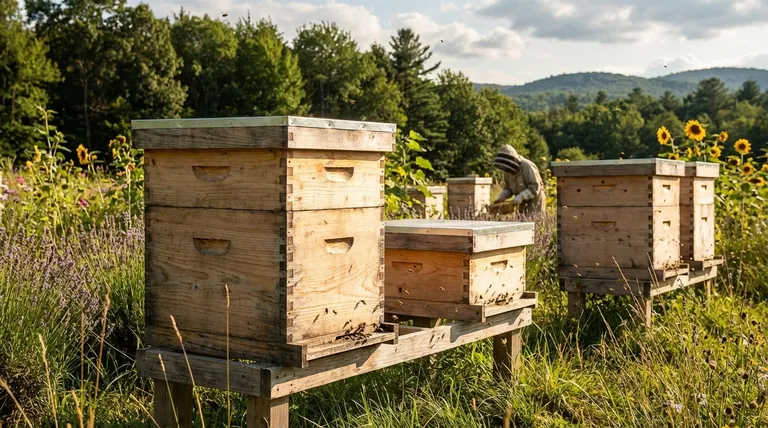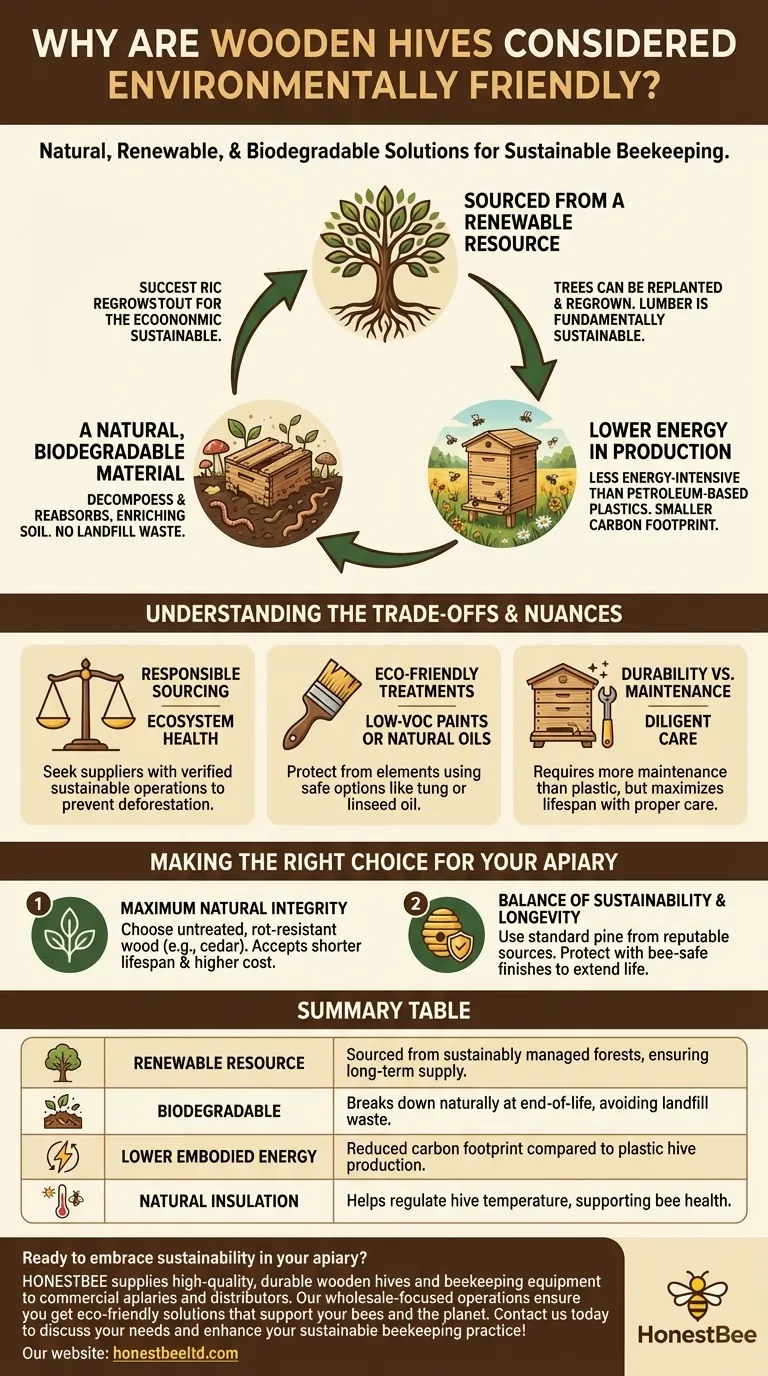At their core, wooden hives are considered environmentally friendly because they are constructed from wood, a natural and renewable resource. Unlike synthetic alternatives, a wooden hive is biodegradable, meaning it can break down and return to the earth at the end of its functional life without leaving behind persistent pollution.
The environmental benefit of a wooden hive extends across its entire lifecycle. From its creation using a renewable material to its safe, natural disposal, wood presents a stark contrast to petroleum-based plastics that persist in the environment for centuries.

The Lifecycle of a Wooden Hive: A Sustainable Loop
The true environmental advantage of a material isn't just one feature, but how it behaves from creation to disposal. Wood performs well at each stage.
Sourced from a Renewable Resource
A renewable resource is one that can be replenished naturally over time. Trees, the source of wood, can be replanted and regrown, making lumber a fundamentally sustainable building material when managed properly.
This stands in direct opposition to materials like plastic, which are derived from finite fossil fuels.
A Natural, Biodegradable Material
At the end of its service, a wooden hive is biodegradable. The organic material will decompose and be reabsorbed by the ecosystem, enriching the soil.
This "cradle-to-cradle" loop ensures the hive does not contribute to landfill waste or long-term environmental contamination.
Lower Energy in Production
Creating a hive box from lumber is generally a less energy-intensive process than synthesizing and molding petroleum-based plastics.
This lower embodied energy means a smaller carbon footprint is associated with the manufacturing of the hive itself.
Understanding the Trade-offs and Nuances
While wood is a strong environmental choice, a truly informed decision requires acknowledging its practical limitations and sourcing considerations.
The Critical Role of Sourcing
Not all wood is harvested equally. The greatest environmental benefit comes from wood sourced from responsibly managed forests.
When possible, seek out suppliers who can verify their lumber comes from operations that prioritize replanting and ecosystem health, preventing deforestation.
The Impact of Preservatives and Paints
To maximize its lifespan, a wooden hive must be protected from the elements. Raw, untreated wood will rot quickly.
Beekeepers must use paints, stains, or oils. The choice of preservative has its own environmental impact. Opting for low-VOC (Volatile Organic Compound) paints or natural oils like tung or linseed oil minimizes the release of harmful chemicals.
Durability vs. Maintenance
Wooden hives require more maintenance than their plastic counterparts and are more susceptible to rot and pests.
This creates a trade-off: while wood is biodegradable, it may need to be replaced more frequently than plastic, consuming more resources over the long term if not properly cared for. Diligent maintenance is key to maximizing its lifespan and, therefore, its sustainability.
Making the Right Choice for Your Apiary
Your choice of hive material should align with your specific goals for sustainability and apiary management.
- If your primary focus is maximum natural integrity: Choose an untreated hive made from a durable, rot-resistant wood like cedar, and accept the shorter lifespan and higher cost.
- If your primary focus is a balance of sustainability and longevity: Use a standard pine hive from a reputable source and protect it with a bee-safe, low-VOC exterior paint or natural oil finish to maximize its functional life.
Ultimately, choosing a wooden hive is a strong step toward a more sustainable beekeeping practice.
Summary Table:
| Environmental Feature | Benefit for Beekeepers |
|---|---|
| Renewable Resource | Sourced from sustainably managed forests, ensuring long-term supply. |
| Biodegradable | Breaks down naturally at end-of-life, avoiding landfill waste. |
| Lower Embodied Energy | Reduced carbon footprint compared to plastic hive production. |
| Natural Insulation | Helps regulate hive temperature, supporting bee health. |
Ready to embrace sustainability in your apiary? HONESTBEE supplies high-quality, durable wooden hives and beekeeping equipment to commercial apiaries and distributors. Our wholesale-focused operations ensure you get eco-friendly solutions that support your bees and the planet. Contact us today to discuss your needs and enhance your sustainable beekeeping practice!
Visual Guide

Related Products
- Langstroth Bee Hives Bee Keeping Box for Beginners Beekeeping
- Australian Langstroth Beehive Boxes for Beekeeping Wholesales
- Wholesales Dadant Size Wooden Bee Hives for Beekeeping
- Langstroth Honey Bee Box Hive Boxes for Different Depths
- HONESTBEE Professional Long Handled Hive Tool with Precision Cutting Blade
People Also Ask
- What is the best type of bee hive for beginners? Start with the Proven Langstroth Standard
- Why might a beginner be advised to start with a Langstroth hive? Unlock a Supportive Beekeeping Ecosystem
- Should a beginner try a different type of hive? Start with a Langstroth for a solid foundation.
- Why were wooden hives traditionally preferred? For Natural Beekeeping Aligned with Bee Biology
- How does the orientation of the hive sides benefit comb construction? Ensure Straight, Movable Combs for Easier Hive Management



















